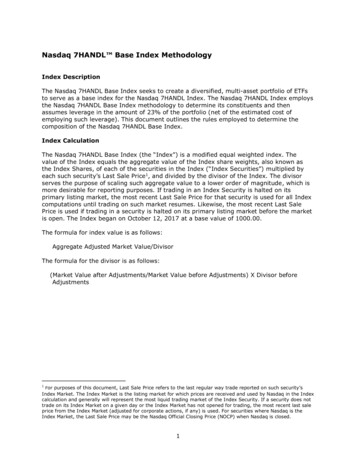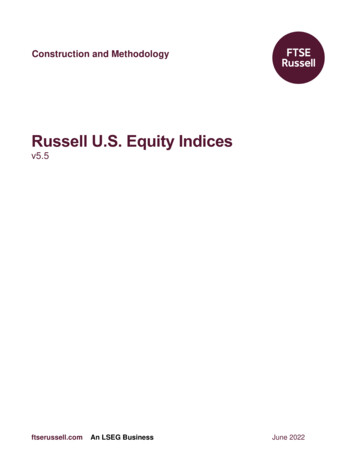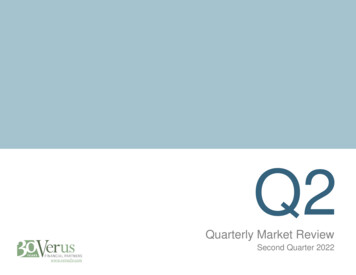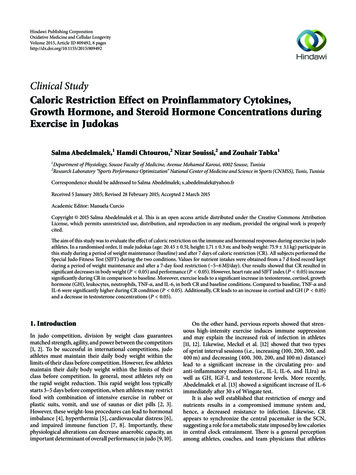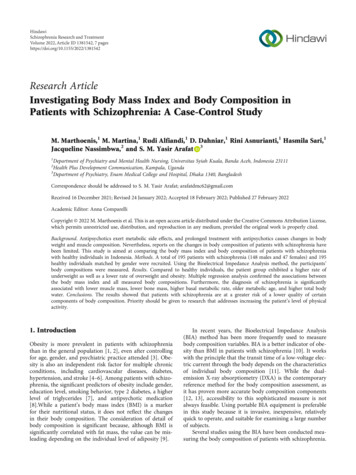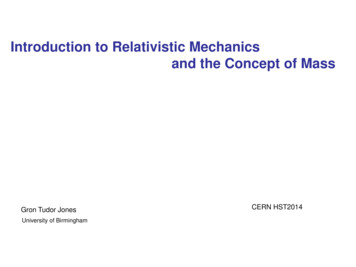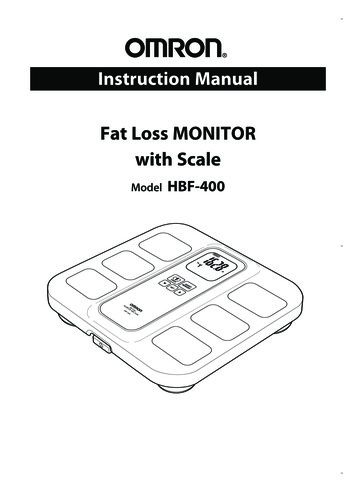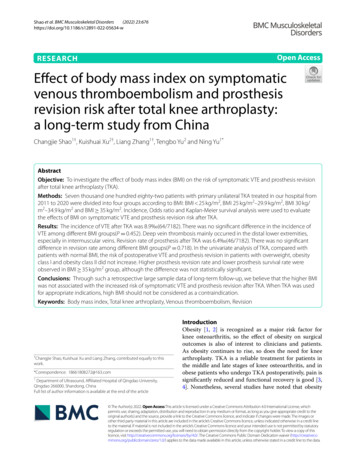
Transcription
(2022) 23:676Shao et al. BMC Musculoskeletal wOpen AccessRESEARCHEffect of body mass index on symptomaticvenous thromboembolism and prosthesisrevision risk after total knee arthroplasty:a long‑term study from ChinaChangjie Shao1†, Kuishuai Xu2†, Liang Zhang1†, Tengbo Yu2 and Ning Yu1*AbstractObjective: To investigate the effect of body mass index (BMI) on the risk of symptomatic VTE and prosthesis revisionafter total knee arthroplasty (TKA).Methods: Seven thousand one hundred eighty-two patients with primary unilateral TKA treated in our hospital from2011 to 2020 were divided into four groups according to BMI: BMI 25 kg/m2, BMI 25 kg/m2–29.9 kg/m2, BMI 30 kg/m2–34.9 kg/m2 and BMI 35 kg/m2. Incidence, Odds ratio and Kaplan-Meier survival analysis were used to evaluatethe effects of BMI on symptomatic VTE and prosthesis revision risk after TKA.Results: The incidence of VTE after TKA was 8.9‰(64/7182). There was no significant difference in the incidence ofVTE among different BMI groups(P 0.452). Deep vein thrombosis mainly occurred in the distal lower extremities,especially in intermuscular veins. Revision rate of prosthesis after TKA was 6.4‰(46/7182). There was no significantdifference in revision rate among different BMI groups(P 0.718). In the univariate analysis of TKA, compared withpatients with normal BMI, the risk of postoperative VTE and prosthesis revision in patients with overweight, obesityclass I and obesity class II did not increase. Higher prosthesis revision rate and lower prosthesis survival rate wereobserved in BMI 35 kg/m2 group, although the difference was not statistically significant.Conclusions: Through such a retrospective large sample data of long-term follow-up, we believe that the higher BMIwas not associated with the increased risk of symptomatic VTE and prosthesis revision after TKA. When TKA was usedfor appropriate indications, high BMI should not be considered as a contraindication.Keywords: Body mass index, Total knee arthroplasty, Venous thromboembolism, Revision†Changjie Shao, Kuishuai Xu and Liang Zhang, contributed equally to thiswork.*Correspondence: 18661808272@163.com1Department of Ultrasound, Affiliated Hospital of Qingdao University,Qingdao 266000, Shandong, ChinaFull list of author information is available at the end of the articleIntroductionObesity [1, 2] is recognized as a major risk factor forknee osteoarthritis, so the effect of obesity on surgicaloutcomes is also of interest to clinicians and patients.As obesity continues to rise, so does the need for kneearthroplasty. TKA is a reliable treatment for patients inthe middle and late stages of knee osteoarthritis, and inobese patients who undergo TKA postoperatively, pain issignificantly reduced and functional recovery is good [3,4]. Nonetheless, several studies have noted that obesity The Author(s) 2022. Open Access This article is licensed under a Creative Commons Attribution 4.0 International License, whichpermits use, sharing, adaptation, distribution and reproduction in any medium or format, as long as you give appropriate credit to theoriginal author(s) and the source, provide a link to the Creative Commons licence, and indicate if changes were made. The images orother third party material in this article are included in the article’s Creative Commons licence, unless indicated otherwise in a credit lineto the material. If material is not included in the article’s Creative Commons licence and your intended use is not permitted by statutoryregulation or exceeds the permitted use, you will need to obtain permission directly from the copyright holder. To view a copy of thislicence, visit http:// creat iveco mmons. org/ licen ses/ by/4. 0/. The Creative Commons Public Domain Dedication waiver (http:// creat iveco mmons. org/ publi cdoma in/ zero/1. 0/) applies to the data made available in this article, unless otherwise stated in a credit line to the data.
Shao et al. BMC Musculoskeletal Disorders(2022) 23:676increases the rate of perioperative complications afterTKA, such as increased overall revision surgery ratesdue to infection [5–9], and increased rates of VTE events(defined as deep vein thrombosis (DVT) or pulmonaryembolism (PE)) [10–12]. However, part of the studieswere limited by sample size and the results need to beinterpreted with caution.Some recent studies [13–17] have expressed theopposite view that there is no association between BMIand the occurrence of VTE events after TKA and theincreased risk of prosthesis revision. Crookes et al. [16]showed that there was no significant difference in VTEevents between patients with morbidly obese (BMI 40 kg/m2) and patients with BMI 40 kg/m2. Tang et al.[17] divided the patients into 5 groups according to BMIand found that there was no statistical difference in theincidence of total VTE among different BMI groups.Molloy et al. [13] conducted a prospective study over aperiod of 10 years, and the results showed that therewas no difference in the survival rate of implant survivalamong different BMI groups. A multicenter retrospectivestudy conducted by Affatato et al. [14] found that obeseand morbidly obese patients benefited as much fromtotal knee arthroplasty as non-obese patients, and nostatistical difference in prosthesis survival was observed.Another meta-analysis [15] concluded that the meanrevision rate in obese patients (BMI 30 kg/m2) was 0.33%pa (95%CI-3.16 to 2.5) higher than in non-obese patients,however this was not statistically significant (p 0.82).Therefore, it is not clear whether patients with elevatedBMI are more likely to develop VTE and have a higherprosthesis revision rate than patients with normal BMI,and as far as we know, few studies have analyzed theincidence of thrombosis and prosthesis revision rate inpatients after TKA. The purpose of this study includestwo aspects: (1) To evaluate whether the increase of BMIwill increase the risk of symptomatic VTE and prosthesis revision after TKA. (2) The distribution and imagingcharacteristics of lower extremity deep venous thrombosis were recorded, and the reasons for prosthesis revisionwere descriptively analyzed.Materials and methodsPatient selectionThis study is a retrospective study. After the approvalof our institutional review committee (QYFL WZLL26879), we searched the clinical data of 11,514 patientswho underwent TKA from January 2011 to December 2020 in our hospital. Inclusion criteria: 1) Meet theclinical diagnosis of knee osteoarthritis; (2) All patientsunderwent primary unilateral TKA; (3) No rheumatism/inflammatory arthritis. Exclusion criteria: (1) Previoushistory of thrombosis or preoperative diagnosis of lowerPage 2 of 8extremity DVT; (2) Patients with recent history of fracture or bone tumor; (3) Incomplete clinical data or lossof follow-up; Finally, 7182 patients were included in ourcohort study. A detailed case review was conducted foreach patient, and the collected clinical data included;Gender, age, affected side, operation time, length of stayand number of combined diseases. At the same time,record the patient’s height and weight, and calculate theBMI (weight divided by the square of the height).Surgical technique and data collectionThe operation of all patients was completed by the experienced chief physician of our hospital. Tourniquet wasused throughout the operation. All patients were treatedwith medial approach. Patellar replacement was not routinely performed. The femoral prosthesis and tibial prosthesis was fixed with bone cement. Polyethylene spacerwas installed. The thumbless test, knee joint stability andgood range of motion were examined.All patients were followed-up by outpatient, medicalrecord system and telephone to determine the incidenceof VTE events and prosthesis revision after TKA, and thecauses of revision were descriptive statistics. The diagnostic indicators of VTE include: (1) clinical manifestations: persistent pain, swelling, local deep tenderness,pain in posterior flexion and restricted movement ofthe lower limbs and other discomfort, DVT of the lowerlimbs should be suspected; Postoperative unexplainedshortness of breath, dyspnea, chest pain, syncope, hypotensive shock should be suspected as PE. (2) Laboratorytests showed elevated D-dimer. In case of the above,color Doppler ultrasound was immediately performed.If PE was suspected, the diagnosis was confirmed bytranspulmonary CT angiography. We also recorded thelocation of the thrombus, thrombus echogenicity (hyperechoic, hypoechoic), number of involved vessels, andtotal thrombus length.ExposurePatients were classified into four sub-groups a priori based on BMI at the time of surgery. Groups wereBMI 25 kg/m2(normal),BMI25 kg/m2–29.9 kg/22m (overweight), BMI30 kg/m –34.9 kg/m2 (obesity classI) and BMI 35 kg/m2 (obesity class II), and are consistent with the classifications of obesity defined by theWorld Health Organization.Statistical analysisData analysis was performed using SPSS 25.0 statistical software. The measurement data with normal distribution and homogeneous variance are expressed bymean standard deviation. The independent samplet-test is used for the comparison between groups, and
Shao et al. BMC Musculoskeletal Disorders(2022) 23:676Page 3 of 8Table 1 Baseline characteristics according to four body mass index (BMI) categoriesBMI 25(n 2036)BMI25–29.9(n 3691)BMI30–34.9(n 1279)BMI 35(n 176)P66.6 8.266.0 7.364.9 7.163.8 8.2 610431870688909.2 3.69.2 4.39.4 3.8Age, mean SDSex0.003Affected sideLeftRightLength of staySurgery time, minsTotal expense, RMBBMI, mean SDNumber of combinedunderlying diseases0.28983.2 25.749,141.8 17,126.622.9 1.783.7 25.89.9 4.185.2 24.657,477.6 22,957.558,515.8 16,421.827.3 1.431.8 1.438.1 3.90715115135953683128744760 2638125347363ResultPatientsDuring the study period, 11,514 patients with knee osteoarthritis were evaluated. According to the exclusion criteria, 7182 patients were enrolled in the study cohort,including 2264 males and 4918 females, with an averageage of 65.76 7.2 years (range 23–87 years). BMI 25 kg/m2 group 2036 cases (28.3%), BMI 25–29.9 kg/m2 group3691 cases (51.4%), BMI 30–34.9 kg/m2 group 1279 cases(17.8%) and 176 cases (2.5%) in BMI 35 kg/m2 group.The increase in BMI was associated with lower age,higher proportion of women, longer surgery and lengthof stay, more complications and higher hospitalizationcosts, there was no statistically significant differencebetween the groups in terms of surgical side (Table 1).Outcome measuresThe total incidence of VTE events after TKA was 8.9‰(64/7182), including 7.9‰ (16/2036) in BMI 25 kg/m2 0.00171,234.9 25,902.81the non-parametric test is used when the distribution isskewed or the variance is uneven. Enumeration data wereexpressed in frequency or percentage, and chi-squaretest was used for comparison between groups. Univariate logistic regression was used to compare the predictivevalue of obesity category on the incidence of symptomatic VTE and prosthesis revision. The normal weight(BMI 25 kg/m2) category was used as the control group.Kaplan Meier survival curve was drawn and the reviseddata were analyzed. Statistical significance was defined asp value 0.05.0.03189.9 25.1 0.001 0.001 0.001Table 2 Incidence of VTE and prosthesis revision amongdifferent obese categoriesVTE(n 64)Revision(n 46)BMI 2516 (25.0%)14 (30.4%)BMI25–29.939 (60.9%)24 (52.2%)BMI30–34.98 (12.5%)6 (13.1%)BMI 351 (1.6%)2 (4.3%)X22.6301.347P0.4520.718Data on percentage are number of cases/total VTE cases or total revised casesTable 3 Comparison of distribution of deep venous thrombosisamong different obese 2MV56CFV Common femoral vein, DFV Deep femoral vein, SFV Superficial femoral vein,PV popliteal vein, PTV Posterior tibial vein, PeV Peroneal vein, MV Muscular veingroup, 10.6‰ (39/3691) in BMI 25–29.9 kg/m2 group,6.3‰ (8/1279) in BMI 30–34.9 kg/m2 group and 5.7‰(1/176) in BMI 35 kg/m2 (Table 2). From Table 3, it is
Shao et al. BMC Musculoskeletal Disorders(2022) 23:676Page 4 of 8not difficult to find that most deep venous thrombosismainly occurs in the distal lower extremities, especially inthe intermuscular veins, as high as 87.5% (56/64). Therewas no statistical difference in thrombus echo, thrombuslength and the number of blood vessels involved amongdifferent BMI groups (P 0.05) (Table 4).A total of 46 revisions were made throughout the studyperiod, with a total revision rate of 6.4‰ (46/7182).The revision rate was 6.9‰ (14/2036) in BMI 25 kg/m2 group, 6.5‰ (24/3691) in BMI 25–29.9 kg/m2group, 4.7‰ (6/1279) in BMI 30–34.9 kg/m2 group and11.4‰ (2/176) in BMI 35 kg/m2 group. Patients withBMI 35 kg/m2 had a relatively higher risk of prosthesisrevision (Fig. 1), although there was no significant difference in prosthesis revision rate among different BMIgroups (P 0.718) (Table 2). In the univariate analysis ofTable 4 Comparison of imaging characteristics of lower limb vascular ultrasound among different obese categoriesBMI 25BMI25–29.9BMI30–34.9BMI 3592160Number of embolized vessels10.335221001 35820163780EchogenicityHypoechoicHyperechoicMean vein diameter (mm)P0.072020150.3 29.146.7 27.642.6 13.656.0Fig. 1 Bar graph illustration of VTE and revision rate among all BMI groups0.910
Shao et al. BMC Musculoskeletal Disorders(2022) 23:676Page 5 of 8Table 5 Results of univariate regression models comparing the outcomes of VTE and revisions among different obese categoriesGroupsBMI25–29.9 vs. BMI 25BMI30–34.9 vs. BMI 25BMI 35 vs. BMI .4311.66(0.37–7.36)0.505Table 6 Reason for revision and revision rateReasonCase(n 46)Rate(%)Periprosthetic joint infection2656.5Aseptic loosening919.6Pain without loosening48.7Periprosthetic Fracture24.3Knee instability24.3Dislocation12.2Liner wear12.2Stiffness12.2Data on percentage are number of cases/total revised casesTKA, compared with patients with normal BMI, the riskof postoperative VTE and prosthesis revision in patientswith overweight, obesity class I and obesity class II didnot increase (Table 5).With regard to the causes of prosthesis revision: In 46patients with revision, our data showed that infection wasthe main cause of revision (26/46), followed by asepticloosening (9/46) (Table 6). Kaplan-Meier survival analysis showed that: graphically, survival did not appear tobe different between BMI 25 kg/m2, BMI 25–29.9 kg/m2and BMI 30–34.9 kg/m2, and the group with BMI 35 kg/m2 had a relatively low prosthesis survival rate, with a10-year survival rate of 98.9%, but the difference was notstatistically significant (Fig. 2).Fig. 2 Survival curve of Kaplan–Meier prosthesis in four body mass index (BMI) categories
Shao et al. BMC Musculoskeletal Disorders(2022) 23:676DiscussionThe occurrence of VTE events after TKA can lead toserious outcomes, including high mortality, prolongedhospitalization and increased hospitalization costs,etc. [18], and the revision of postoperative prosthesis ismore a psychological and economic burden to patients.Therefore, preventing the occurrence of VTE events andprosthesis revision remain important tasks for qualityimprovement programs after TKA. But current literatureis still conflicting about the effect of obesity on symptomatic VTE and prosthetic revision after TKA, and part ofthe literature is affected by small sample size or the rarity of VTE events. This study therefore sought to addressthis major question: whether BMI is associated with anincreased risk of VTE events and prosthetic revision afterTKA.With regard to the risk of VTE after TKA in different BMI populations, Mantilla et al. [12] conducted aretrospective case-control study to determine the clinically related risk factors of DVT and PE after TKA, theyfound that obesity defined as BMI 30 kg/m2 imparted a3.4 times elevated risk of VTE compared with controls.In addition, White et al. [19] concluded that BMI 25 kg/m2 was associated with subsequent hospitalization forthromboembolism when evaluating VTE risk factors forre-hospitalization after TKA. However, Friedman et al.[20] found that morbid obesity is only associated with anincrease in early postoperative complications, not with anincreased risk of VTE or bleeding. Cafri et al. [21] conducted a study followed-up for 10 to 18 years, the resultsshowed that there was no statistically significant difference in DVT between obese and non-obese patients afterTKA. Tang et al. [17] showed that the total incidence ofVTE in different BMI groups was statistically similar.However, the sample size in some of the above studiesis relatively small and may not be sufficient to detect differences between groups. The advantages of our studyare large sample size, long follow-up time, and detaileddescription of the incidence of DVT, ultrasonographicfeatures and thrombus distribution in different BMIgroups. Rigorous statistical analysis of our data showsthat there is no correlation between the increase in BMIand the increased risk of VTE events after TKA. This isconsistent with the results of Sloan et al. [22] Sloan andcolleagues reviewed the American College of SurgeonsNational Surgical Quality Improvement Program (ACSNSQIP) database, which included 218,997 patients withinitial TKA and 15,286 patients with revised TKA, andconcluded that patient classification as overweight orobese is associated with increased risk of developmentof PE but not DVT after TKA. Xu et al. [23] conducteda nested case-control study based on a large data set of15,326 patients. The results showed that BMI was not aPage 6 of 8risk factor for DVT after TKA. This report also confirmsour point of view.In this study, the incidence of VTE events after TKAwas 0.89%, which was lower than that reported in previous studies [24, 25]. However, similar to the results foundin the Asian population, Tay et al. [26] reported a lowprevalence of VTE in their study population (0.67%); Acohort study based on the Taiwan population found thatthe total incidence of VTE after TKA was 0.64% [27]. Thedifference in incidence may be due to differences in race,number of subjects, follow-up time and use of anticoagulants. As this systematic review [28] concludes, black raceas a risk factor for VTE for TKA, while Hispanic raceshowed no significant difference when compared to thewhite race. In our study, the accuracy of lower limb vascular ultrasound in the diagnosis of DVT may be lowerthan that of lower limb deep venography, but it has theadvantages of non-invasive and convenient. In addition,lower limb vascular ultrasound can also improve a lot ofthrombus-related information for us, including thrombus location, thrombus echo and thrombus length, sothat we can carry out statistical analysis. Our data suggest that deep venous thrombosis occurs mainly in thecalf intermuscular vein (56/64), and the echo of thrombus is mainly hypoechoic. No statistical differences wereobserved in thrombus length, thrombus echo and thenumber of blood vessels involved among different BMIgroups, but a larger sample size is needed for more indepth study in the future to verify our conclusions.Regarding the risk of prosthetic revision after TKA indifferent BMI populations, it has been a hot spot of clinical research and is also widely debated. Previous studies [29] have shown that prosthetic revision rates aresimilar in patients with a BMI 35 kg/m2, but are significantly increased at a BMI 35 kg/m2. Electricwala et al.[30] suggested that an elevated BMI is a risk factor forearly referral to a tertiary care center for revision TKA.However, some studies [31–33] reported the oppositeconclusion. Ayyar and colleagues [32] did not observe adifference in the number of revisions between differentBMI levels, and they suggested that surgery provides asimilar degree of benefit regardless of the patient’s BMIlevel. Gaillard et al. [33] investigated the long-term survival of the prosthesis using Kaplan-Meier analysis andshowed that obesity had no effect on the medium-termprosthesis survival. The present study confirms the latterstatement. Our study showed that no statistical difference was found in the risk of prosthetic revision betweendifferent BMI groups, and we believe that a higher BMIshould not be considered a risk factor for revision formechanical purposes.We also found no significant difference in the 10-yearsurvival rates of prosthetic in different BMI groups, and
Shao et al. BMC Musculoskeletal Disorders(2022) 23:676although patients with a BMI 35 kg/m2 had relativelypoor survival rates, the differences were not statisticallysignificant, and our findings are supported by a recentstudy [34]. On the other hand, the results shown in ourdata are encouraging, with 10-year survival rates of 98%or higher for all BMI groups. Interestingly, patientsin the overweight and obese class I had the highest10-year survival and those in the normal BMI rangehad the worst survival, this is counter-intuitive, as mostpeople tend to associate healthy weight range withincreased prosthetic survival. However, this differenceis not obvious, and whether there is a universal lawremains to be further studied. In addition, descriptivestatistics were also performed for the reasons for revision in our study, which showed that infection was theleading cause of revision (26/46), followed by asepticloosening (9/46), which was consistent with the resultsof several previous studies reporting the causes of prosthetic revision [30, 35, 36]. Bozic et al. [35] reportedthat the most common reasons for revision TKA wereinfection (25.2%) and implant loosening (16.1%). Hossain et al. [36] reported that common causes of revision TKA included infection (32.7%), aseptic loosening(14.9%), and polyethylene wear (12.3%). In summary,periprosthetic infection is still the most common causeof revision and re-revision TKA.Our research also has some limitations. First, this isa retrospective study conducted in a single institution.This may limit the external effectiveness of our study,and multicenter studies are needed to further verify ourconclusions; Second, some patients may have undergonerevision surgery in another hospital without reportingthis information to us. However, as far as we know, thissituation is rare. Third, the study could not comment onBMI-wide extremes. There were not many patients inour cohort with class III obesity (BMI 40 kg/m2) only34 patients. Finally, some patients have a short follow-upperiod, which may be considered a limitation for patientswith shorter follow-up time, considering that asepticprosthesis loosening may occur during long-term followup. Therefore, in the context of these restrictions, ourresults must be interpreted carefully.ConclusionIn this study, we concluded that patients withBMI 35 kg/m2 had a relatively high revision risk,although the difference was not statistically significant,and that higher BMI was not related to the increased riskof VTE events and prosthesis revision after TKA. Basedon these findings, we believe that high BMI should notbe regarded as a surgical contraindication when TKA isused for appropriate indications.Page 7 of 8AcknowledgementsWe would like to thank all the staff in Department of Orthopedic surgery andDepartment of Ultrasound, Affiliated Hospital of Qingdao University for theircontribution on our research.Authors’ contributionsCJS and NY designed this study, LZ and TRW collected the clinical data andfollow-up details of this study, CJS, KSX and LZ performed the statistical analysis, CJS and KSX drafted the manuscript, YN revised the manuscript. All authorsread and approved the final manuscript.FundingThe authors did not receive support from any organization for the submittedwork.Availability of data and materialsThe datasets generated during and/or analyzed during the current study areavailable from the corresponding author on reasonable request.DeclarationsEthics approval and consent to participateThis retrospective chart review study involving human participants wasin accordance with the ethical standards of the institutional and nationalresearch committee and with the 1964 Helsinki Declaration and its lateramendments or comparable ethical standards. The Human Investigation Committee (IRB) of University Qingdao approved this study (QYFY WZLL 26879).Consent for publicationInformed consent was obtained from all individual participants included inthe study.Competing interestsThe authors have no relevant financial or non-financial interests to disclose.Author details1Department of Ultrasound, Affiliated Hospital of Qingdao University, Qingdao 266000, Shandong, China. 2 Department of Orthopaedic Surgery, AffiliatedHospital of Qingdao University, Qingdao 266000, Shandong, China.Received: 6 April 2022 Accepted: 30 June 2022References1. Kulkarni K, Karssiens T, Kumar V, et al. Obesity and osteoarthritis [J]. Maturitas. 2016;89:22–8.2. Martin JR, Jennings JM, Dennis DA. Morbid obesity and Total kneearthroplasty: A growing problem [J]. J Am Acad Orthop Surg.2017;25(3):188–94.3. Collins RA, Walmsley PJ, Amin AK, et al. Does obesity influence clinicaloutcome at nine years following total knee replacement? [J]. J Bone JointSurg Br. 2012;94(10):1351–5.4. Jackson MP, Sexton SA, Walter WL, et al. The impact of obesity on themid-term outcome of cementless total knee replacement [J]. J BoneJoint Surg Br. 2009;91(8):1044–8.5. Amin AK, Clayton RA, Patton JT, et al. Total knee replacement in morbidlyobese patients. Results of a prospective, matched study [J]. J Bone JointSurg Br. 2006;88(10):1321–6.6. Foran JR, Mont MA, Etienne G, et al. The outcome of total knee arthroplasty in obese patients [J]. J Bone Joint Surg Br Am. 2004;86(8):1609–15.7. Culliford D, Maskell J, Judge A, et al. A population-based survival analysisdescribing the association of body mass index on time to revision fortotal hip and knee replacements: results from the UK general practiceresearch database [J]. BMJ Open. 2013;3(11):e003614.8. Roche M, Law TY, Kurowicki J, et al. Effect of obesity on Total knee arthroplasty costs and revision rate [J]. J Knee Surg. 2018;31(1):38–42.
Shao et al. BMC Musculoskeletal 23.24.25.26.27.28.29.(2022) 23:676Wagner ER, Kamath AF, Fruth K, et al. Effect of body mass index on reoperation and complications after Total knee arthroplasty [J]. J Bone JointSurg Am. 2016;98(24):2052–60.Si HB, Zeng Y, Shen B, et al. The influence of body mass index on the outcomes of primary total knee arthroplasty [J]. Knee Surg Sports TraumatolArthrosc. 2015;23(6):1824–32.Guan Z, Chen Y, Song Y. Influence of body mass index and age on deepvein thrombosis after total hip and knee arthroplasty. Zhongguo Xiu FuChong Jian Wai Ke Za Zhi. 2006;20(6):611–5.Mantilla CB, Horlocker TT, Schroeder DR, et al. Risk factors for clinicallyrelevant pulmonary embolism and deep venous thrombosis in patientsundergoing primary hip or knee arthroplasty [J]. Anesthesiology.2003;99(3):552–60 discussion 5A.Molloy J, Kennedy J, Jenkins C, et al. Obesity should not be considereda contraindication to medial Oxford UKA: long-term patient-reportedoutcomes and implant survival in 1000 knees [J]. Knee Surg Sports Traumatol Arthrosc. 2019;27(7):2259–65.Affatato S, Caputo D, Bordini B. Does the body mass index influence thelong-term survival of unicompartmental knee prostheses? A retrospective multi-Centre study [J]. Int Orthop. 2019;43(6):1365–70.Musbahi O, Hamilton TW, Crellin AJ, et al. The effect of obesity onrevision rate in unicompartmental knee arthroplasty: a systematicreview and meta-analysis [J]. Knee Surg Sports Traumatol Arthrosc.2021;29(10):3467–77.Crookes PF, Cassidy RS, Machowicz A, et al. Should isolated morbidobesity influence the decision to operate in hip and knee arthroplasty?[J]. Bone & joint open. 2021;2(7):515–21.Tang A, Sicat CS, Singh V, et al. Aspirin use for venous thromboembolism prevention is safe and effective in overweight and obese patientsundergoing revision Total hip and knee arthroplasty [J]. J Arthroplasty.2021;36(7s):S337–s44.Geerts WH, Bergqvist D, Pineo GF, et al. Prevention of venous thromboembolism: American College of Chest Physicians Evidence-Based ClinicalPractice Guidelines (8th Edition) [J]. Chest. 2008;133(6 Suppl):381s–453s.White RH, Gettner S, Newman JM, et al. Predictors of rehospitalization forsymptomatic venous thromboembolism after total hip arthroplasty [J]. NEngl J Med. 2000;343(24):1758–64.Friedman RJ, Hess S, Berkowitz SD, et al. Complication rates after hip orknee arthroplasty in morbidly obese patients [J]. Clin Orthop Relat Res.2013;471(10):3358–66.Cafri G, Paxton EW, Chen Y, et al. Comparative effectiveness and safety ofdrug prophylaxis for prevention of venous thromboembolism after Totalknee arthroplasty [J]. J Arthroplasty. 2017;32(11):3524–8.e1.Sloan M, Sheth N, Lee GC. Is obesity associated with increased riskof deep vein thrombosis or pulmonary embolism after hip andknee arthroplasty? A large database study [J]. Clin Orthop Relat Res.2019;477(3):523–32.Xu H, Zhang S, Xie J, et al. A nested case-control study on the risk factorsof deep vein thrombosis for Chinese after total joint arthroplasty [J]. JOrthop Surg Res. 2019;14(1):188.Shahi A, Chen AF, Tan TL, et al. The incidence and economic burden ofin-hospital venous thromboembolism in the United States [J]. J Arthroplasty. 2017;32(4):1063–6.Migita K, Bito S, Nakamura M, et al. Venous thromboembolism after totaljoint arthroplasty: results from a Japanese multicenter cohort study [J].Arthritis Res Ther. 2014;16(4):R154.Tay K, Bin Abd Razak HR, Tan AH. Obesity and venous thromboembolismin Total knee arthroplasty patients in an Asian population [J]. J
Methods: Seven thousand one hundred eighty-two patients with primary unilateral TKA treated in our hospital from 2011 to 2020 were divided into four groups according to BMI: BMI 25 kg/m2, BMI 25 kg/m2-29.9 kg/m 2, BMI 30 kg/ m2-34.9 kg/m 2 and BMI 35 kg/m 2. Incidence, Odds ratio and Kaplan-Meier survival analysis were used to evaluate
